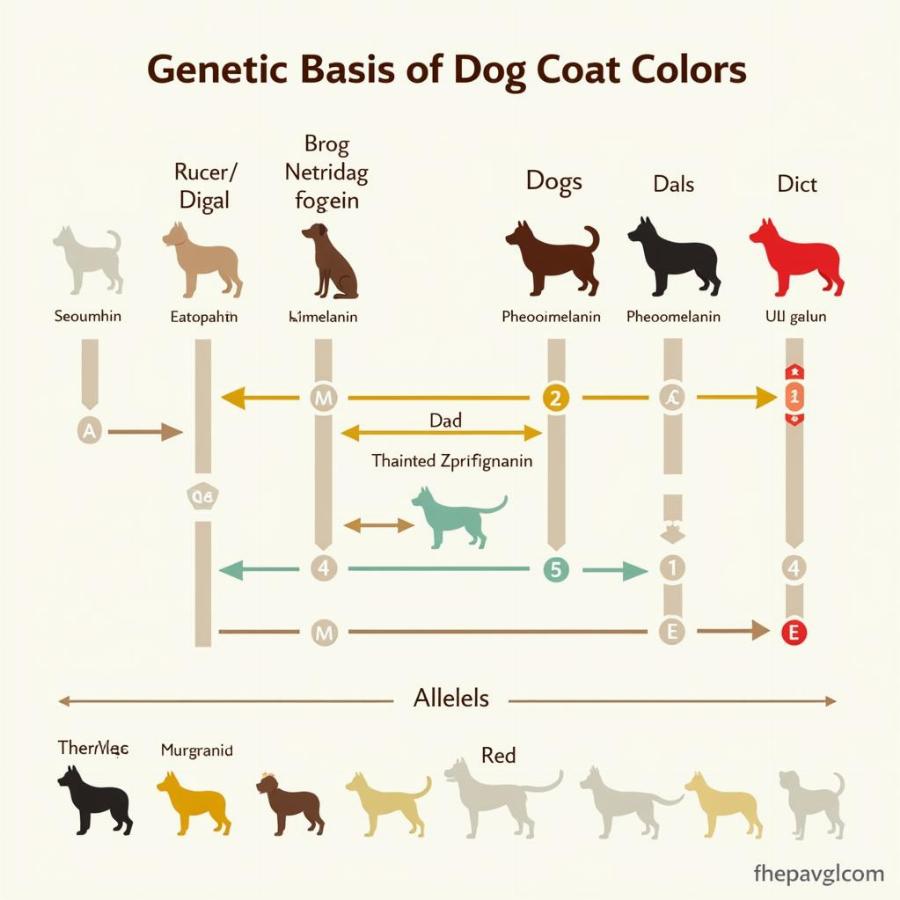Dog color images are a gateway to the diverse and fascinating world of canine coats. From the classic black and white of a Dalmatian to the rich golden hues of a Retriever, dog coat colors and patterns are as varied as the breeds themselves. Understanding the genetics behind these colors, the different patterns they create, and how to best capture them in photographs can be a rewarding experience for any dog lover.
Decoding the Genetics Behind Dog Coat Colors
The stunning array of dog coat colors stems from a complex interplay of genes. These genes control the production and distribution of pigments like eumelanin (black/brown) and pheomelanin (red/yellow). Variations in these genes result in the incredible diversity we see, from solid colors to intricate patterns. For instance, the Merle gene creates mottled patches of color, while the Brindle gene produces tiger-striped patterns.  Di truyền màu lông chó Understanding these genetic factors can help breeders predict the coat colors of future litters and appreciate the intricate beauty of canine genetics.
Di truyền màu lông chó Understanding these genetic factors can help breeders predict the coat colors of future litters and appreciate the intricate beauty of canine genetics.
Capturing the Perfect Dog Color Image
Photographing dogs with different coat colors can be both exciting and challenging. Lighting plays a crucial role in capturing the true richness and depth of a dog’s coat. Natural light is often ideal, but be mindful of harsh midday sun, which can wash out colors. For dark-coated dogs, try to find a backdrop that provides contrast and prevents them from blending in. Conversely, light-colored dogs may benefit from a darker background to make their coat stand out.
Popular Dog Coat Colors and Patterns
Some of the most popular dog coat colors include black, brown, white, red, and fawn. Within these basic colors, a multitude of patterns can occur, adding further variety to the canine world. These patterns include brindle, merle, spotted, ticked, and sable, each with its own distinct charm. Knowing the name of your dog’s color and pattern can be helpful when registering your dog or discussing their appearance with other enthusiasts.
Dog Colors and Personality: Myth or Reality?
While there’s no scientific basis for the idea that coat color dictates personality, certain breeds with specific coat colors are often associated with particular traits. For example, black Labradors are sometimes perceived as more serious and focused, while yellow Labradors are often seen as more playful and outgoing. However, these are generalizations, and individual dog personalities are shaped by a multitude of factors beyond coat color.
Why are Dog Color Images So Popular?
Dog color images offer a visual feast that appeals to a wide range of people. They can be used for educational purposes, to showcase the beauty of different breeds, or simply to bring joy to those who appreciate the canine form. black and brown and white dogs These images often capture the unique personality of each dog, making them even more captivating.
What Can Dog Color Images Tell Us?
Beyond their aesthetic appeal, dog color images can sometimes reveal information about a dog’s health. Changes in coat color, such as dullness or patches of hair loss, can be indicators of underlying health issues.
Conclusion
Dog color images are a captivating window into the fascinating world of canine genetics and aesthetics. From understanding the genetic basis of coat color to capturing the perfect photograph, exploring this colorful realm enhances our appreciation for the incredible diversity and beauty of our canine companions. Remember, the best dog color images are those that capture not just the coat, but also the unique personality shining through. images chiweenie dogs
FAQ
-
What is the most common dog coat color?
- While variations exist, shades of brown are generally considered the most prevalent.
-
Can a dog’s coat color change over time?
- Yes, a dog’s coat can lighten or darken with age, and some breeds experience seasonal color changes.
-
Are certain coat colors associated with health problems?
- Some coat colors and patterns are linked to specific genetic health conditions, such as merle with eye and hearing issues.
-
How can I enhance my dog’s coat color?
- A healthy diet and proper grooming can contribute to a vibrant and healthy coat. dog coloring images
-
What is the rarest dog coat color?
- Truly rare colors depend on breed, but some unusual colors include Isabella (pale fawn) and blue (diluted black).
-
What equipment do I need to take great dog color images?
- A good quality camera with adjustable settings and natural lighting are ideal.
-
Are there any online resources for identifying dog coat colors and patterns?
- Yes, many websites and breed-specific resources offer detailed information on coat color genetics and identification. do intelligent dogs watch tv
Beaut Dogs is your trusted source for all things canine, providing expert advice and resources to help you care for your beloved companion. From breed information to health tips and product recommendations, we’re here to support you every step of the way. When you need assistance, please contact us at Email: [email protected] for detailed and accurate answers from Beaut Dogs. pitbull dog tiger We strive to offer the most comprehensive and reliable information about the world of dogs. Visit https://beautdogs.com today to explore our vast library of resources!